The other morning I happened to be walking through the Bastille market on a Thursday morning. The market also takes place on Sunday morning and is a great market either day, but there are about 80% fewer people there on Thursday, so it’s a lot easier, and less hectic, to shop there.
I’ve been hard at work changing my address with my bank since I moved. I began the process on their website, and it took me a while to track down where to do it under Mon profile > Informations personelles, where you’d think it would be (since that’s where you go to change your phone number, e-mail address, and security code), but alas, it was nowhere to be found.
Digging deeper, I finally thought I found the page to do it, but the website stopped me and said I needed to make a 45-minute appointment with the directrice (director) of the bank. Maybe it’s just me, but it seems like that’s a task that any clerk at a bank should be able to handle, and perhaps the head of the bank has more pressing things to do? But when I tried to book an appointment slot with her, I got an error message that that fonction wasn’t working.
So I grabbed all the paperwork that was necessary, including the all-important electric bill, which is one of the most important documents in France, (just in case someone might be trying to get away with not having electricity or something?) and headed to ma banque.
Fortunately, I got there at 10:50 am since they were inexplicably closing in ten minutes. It’s strange that a bank would just decide to close in the middle of the day, but the woman at the front desk took my file of paperwork and said someone would get back to me…then she shut the door behind me as I left, and locked it for the day.
If I knew that changing my address with my bank was going to be so much work, I wouldn’t have moved.
Speaking of moving, my first apartment in Paris was a block from the Bastille market, and I still have a soft spot for it. After I’d dropped by my bank with round #1 of paperwork, since I’d already had enough drama for one day, and since it was Thursday, I figured strolling over to the nearby Bastille market would be a little relaxing, and would give me time to find “the tomato man,” as my friend Jane, who owns La Cuisine cooking school in Paris, calls him.
There was no sign that he was, indeed, monsieur tomate. But when I came across a stand with some nice-looking tomatoes and a worn metal table next to it with beets, red onions, and tomates cerises, I assumed he was the monsieur I was looking for. In addition to tomatoes, he had a few small bags of fresh piment d’Espelette peppers, a rarity in Paris.
Piment d’Espelette peppers hail from the Pays Basque and are a feature of Basque cooking. They aren’t that spicy but have a distinctive, faintly smoky flavor, and you usually find them powdered, in jars, but sometimes sold dried (whole) as well.
In France, whenever a dish has pimentes in it, or you’re buying them fresh at a market, the servers and market vendors invariably assure customers that they’re pas trop pimenté or pas trop épicé—I always say, “But I like them spicy!” Hot and spicy foods aren’t, um…appreciated here, but these are just moderately so, so there’s no need to worry.
Since I bought a whole bag, I decided to preserve some of my bounty and make chili salt. Making flavored salts is easy since the salt draws out moisture, and there’s little chance of things going wrong since salt is also an excellent preservative.
My kitchen salt of choice is grey sea salt, known as sel gris. And while grey salt is available from different parts of France, and other countries around the world, I have a soft spot for salt from the Guérande. It has a milder salt flavor than table salt or kosher salt and is sold in bags for about €2/kilo, or $1/pound in France. In the U.S., the salt goes for around $6/bag, but it takes me about a year to go through a bag, and I cook a lot, so it’s still a deal. I’m not a huge fan of pink Himalayan salt, but it has a nice consistency and would work well here, too.
Grainy Grey salt has a mild mineral flavor that I like, and is quite moist so tends to clump a bit, but it’s what I’m used to as it’s not acrid as fine table salt is, nor is it as processed. I also find kosher salt, Diamond or Morton, too salty, but I know most people can get that easily in the U.S., so it’s a-okay to use that.
(I do find it interesting that a French company sells kosher salt, but it’s not available in France. I have American friends who live abroad, who bring kosher salt back from the States with them in their suitcases. I used to bring unscented laundry detergent back, but now we can get that, so I can use that suitcase space for pecans, Rancho Gordo beans, California dried apricots, and Stretch-Tite, the latter of which I learned, if it’s not from Costco, it doesn’t come with that fantastic cutter.)
The main point about salt is to use what you like, what’s available to you, and what’s in your budget. That said, there’s quite a difference between the 69¢ canister of table salt, and the box or bag of better salt that costs a few extra bucks, so I recommend treating yourself to good salt. You deserve it!
The process of making chili salt is pretty simple; Split the peppers lengthwise, remove the seeds, grind them with salt in a food processor, and let them dry for a few days. A lot of people are concerned about the seeds, but the seeds are actually not the spicy part of the pepper, so I left them out as I didn’t really want ground seeds in my spicy chili salt.
I was thinking of planting the seeds in our yard but was told peppers just don’t do well in Paris, so I fed the seeds to my compost. But the salt is staying here in my yard, and in my kitchen.
Chili Salt
About 1 1/2 cups
You can use any kind of chiles to make salt, realizing that some chiles are hotter than others. Espelette peppers rank 4 out of 10 on the Scoville scale of spiciness. If you want to use a spicier pepper, feel free to, but maybe use less? Bird’s eye chiles are twice as spicy as Espelettes, for example, so you may have to adjust quantities.
As mentioned, I used grey salt, which is quite humid, and mine took about 2 1/2 days to dry, but if using a drier salt, it’ll probably take less time. The salt is done when you rub it between your fingers and the little bits of chiles feel firm and dry. Don’t touch your eyes or anywhere below the waist with your hands for a while, as getting the chiles in your eyes—or worse, below the belt—can be painful.
Sprinkle this salt over hard-cooked eggs, scrambled eggs, avocado toast, corn on the cob, egg salad, goat cheese, fish, or rice. In the dessert department, I think it might be interesting to sprinkle on a chocolate dessert. My friend Forest suggested using it to rim a glass for a Margarita!
1 1/2 cups (250g) coarse, grainy, or flaky sea salt or kosher salt
5 fresh moderately spicy chiles (80g/2.5oz) [feel free to adjust if using spicier chiles]
1. Coarsely chop the chiles and place in the bowl of a food processor along with the salt. (I used a mini-chopper but you can also very finely chop the chiles by hand and mix them with the salt, or use a blender.)
2. Pulse until the chiles are in small flecks and pieces slightly larger than the grains of salt.
3. Spread the salt in a single layer on a nonreactive baking sheet, tray, or platter. Let sit at room temperature for 1 to 2 days, or until the salt and chiles feel dry when you rub them between your fingers. Store in a jar at room temperature until ready to use.
Fun grammar facts: Many ponder the spelling, and use, of chili versus chile. Our friends at Mirriam-Webster dictionary helpfully include a special section on that, since it varies when the word is used in relation to cooking…as well as depending on where you are, and/or what language you are speaking.
According to them, chile powder is used to describe pure powdered peppers, whereas chili powder is spelled with an “i” when it’s mixed with other spices, and used as a seasoning or preparing chili, the dish.
This post is for all subscribers. Thanks for subscribing!






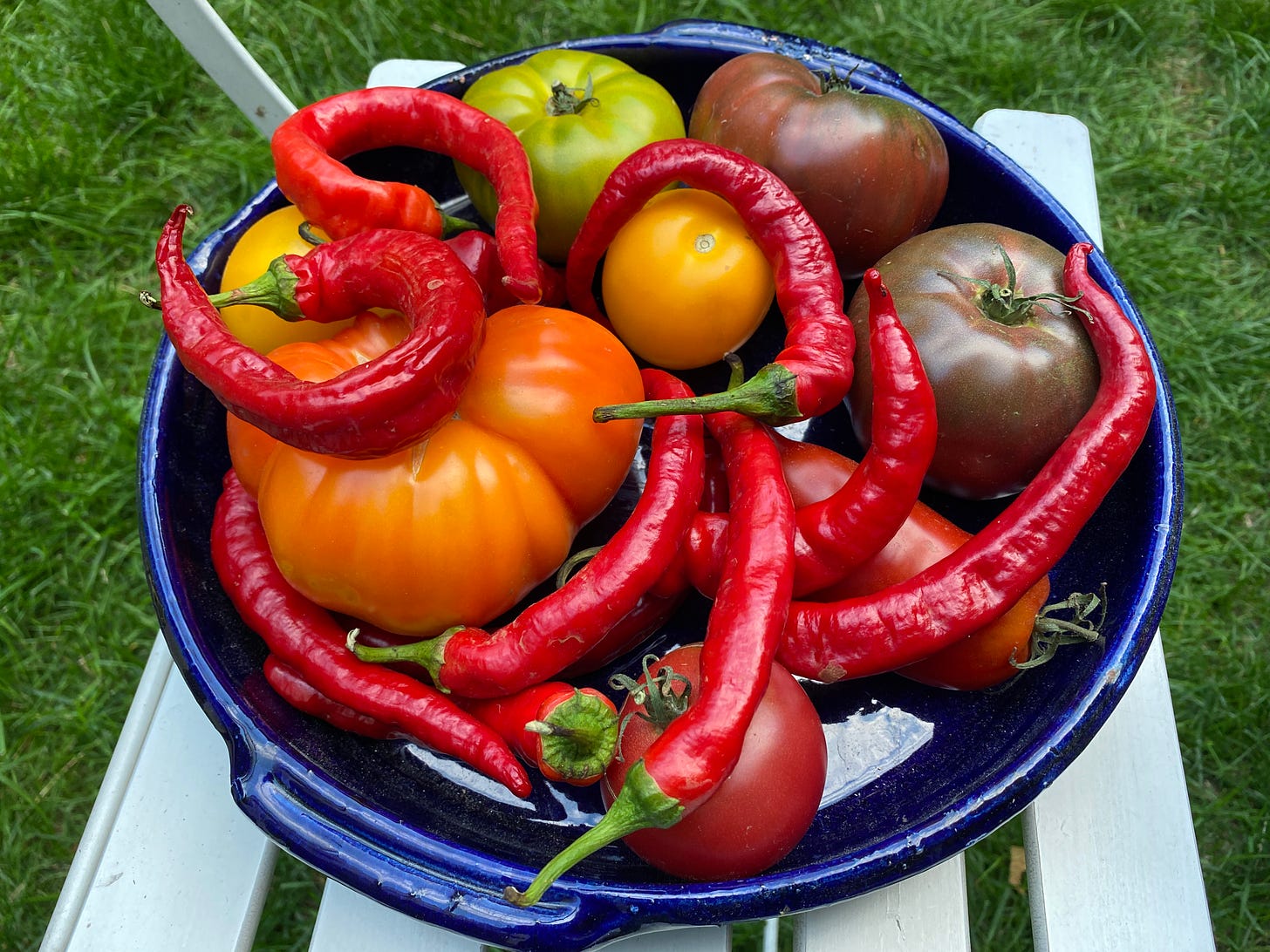


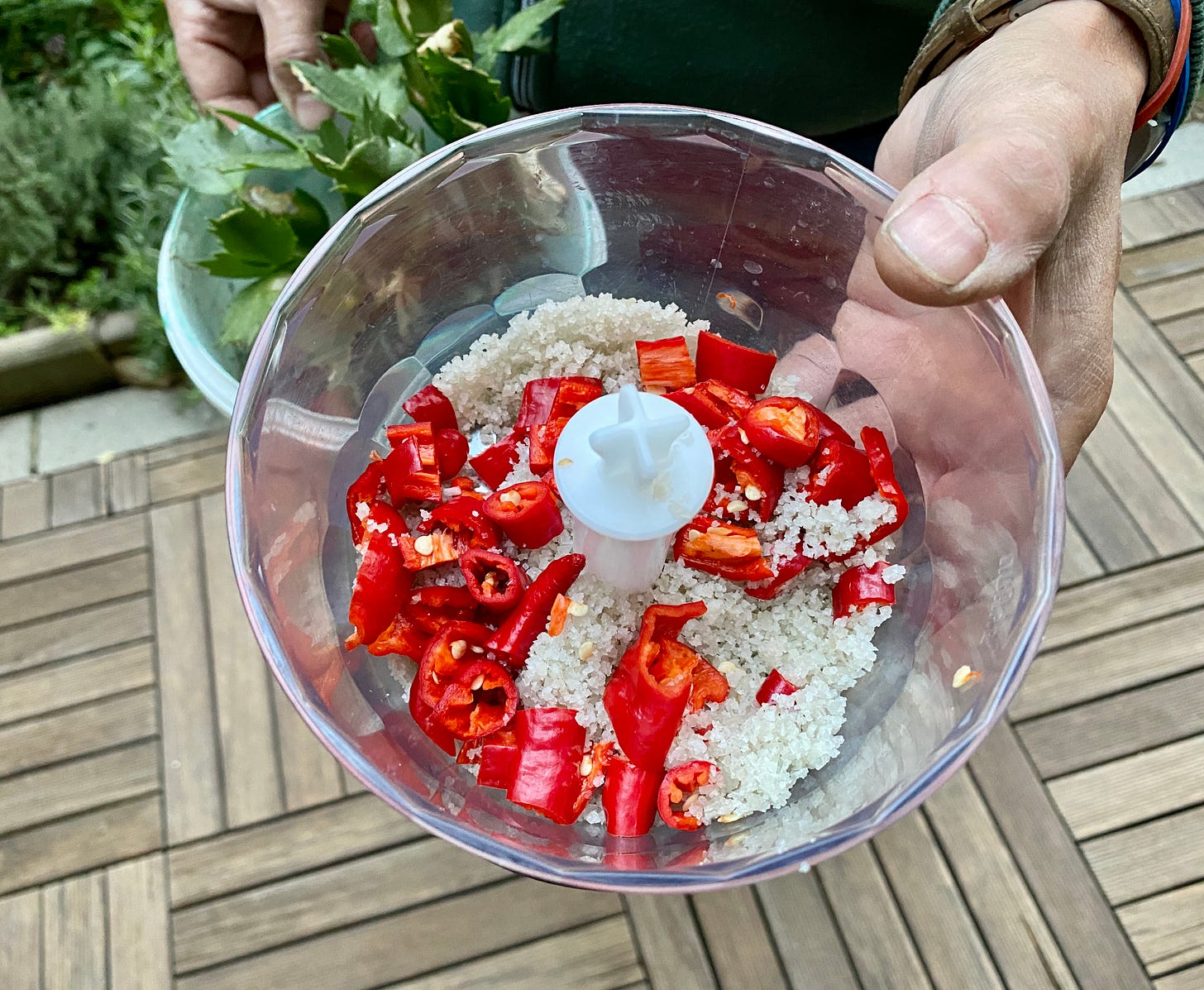
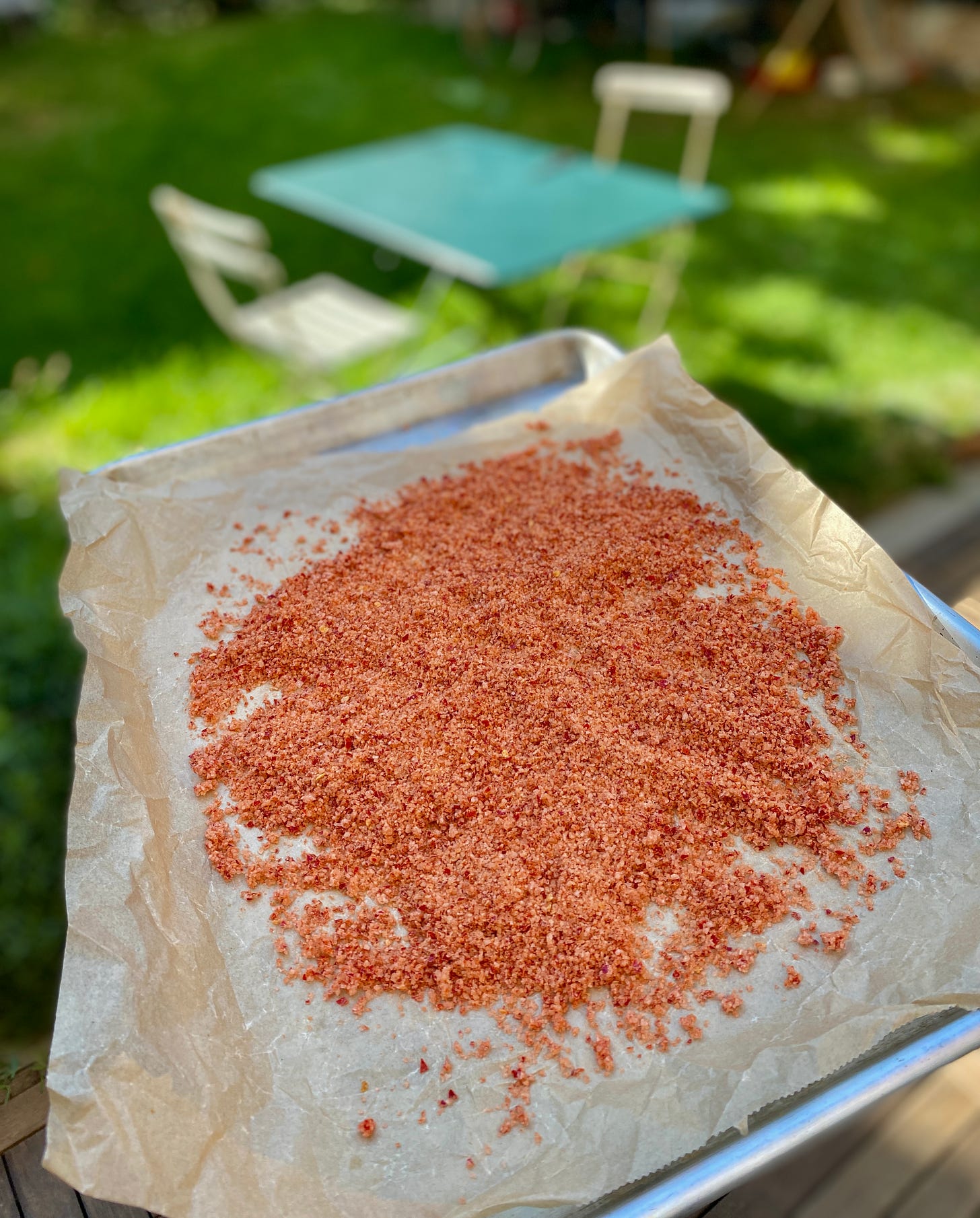
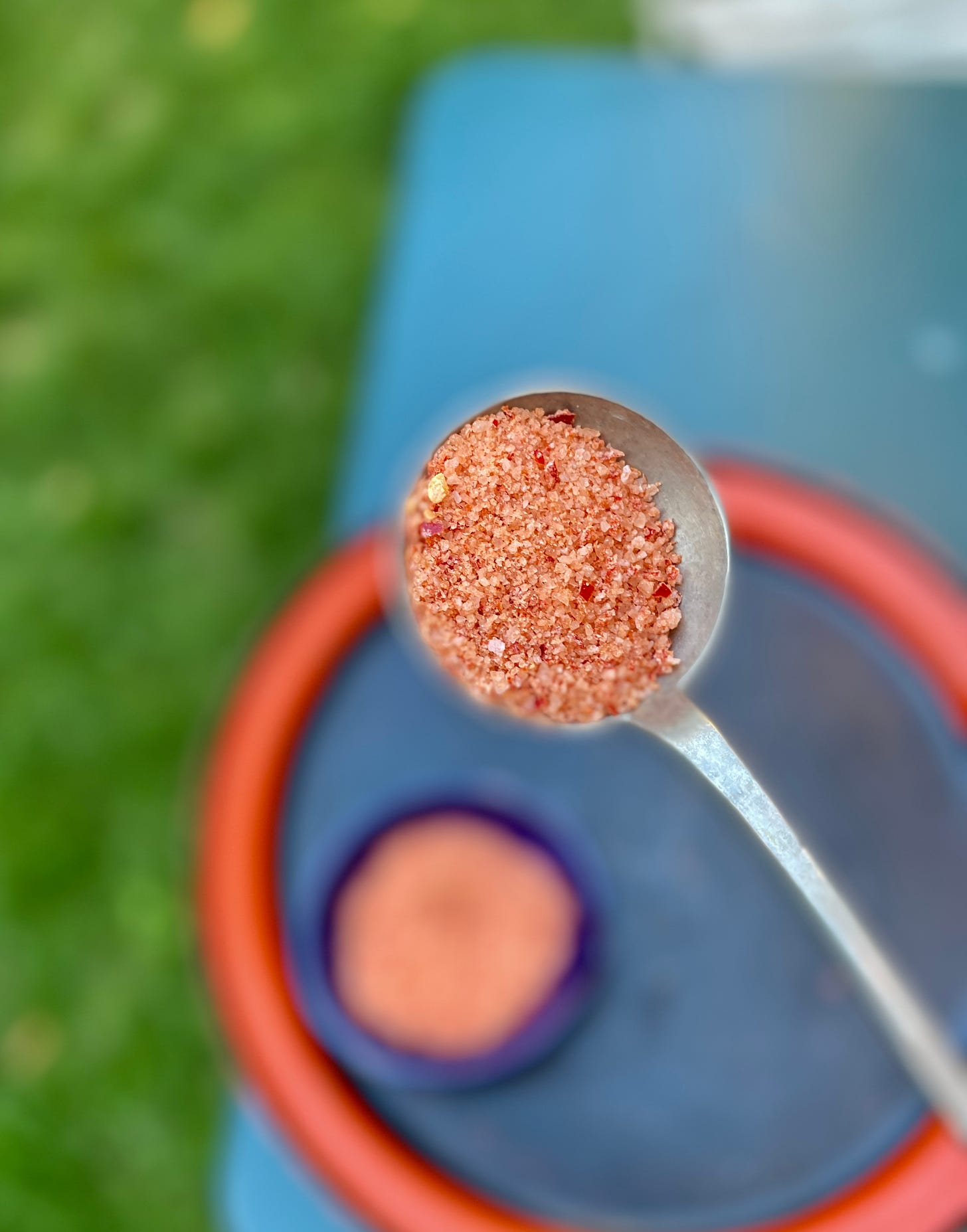
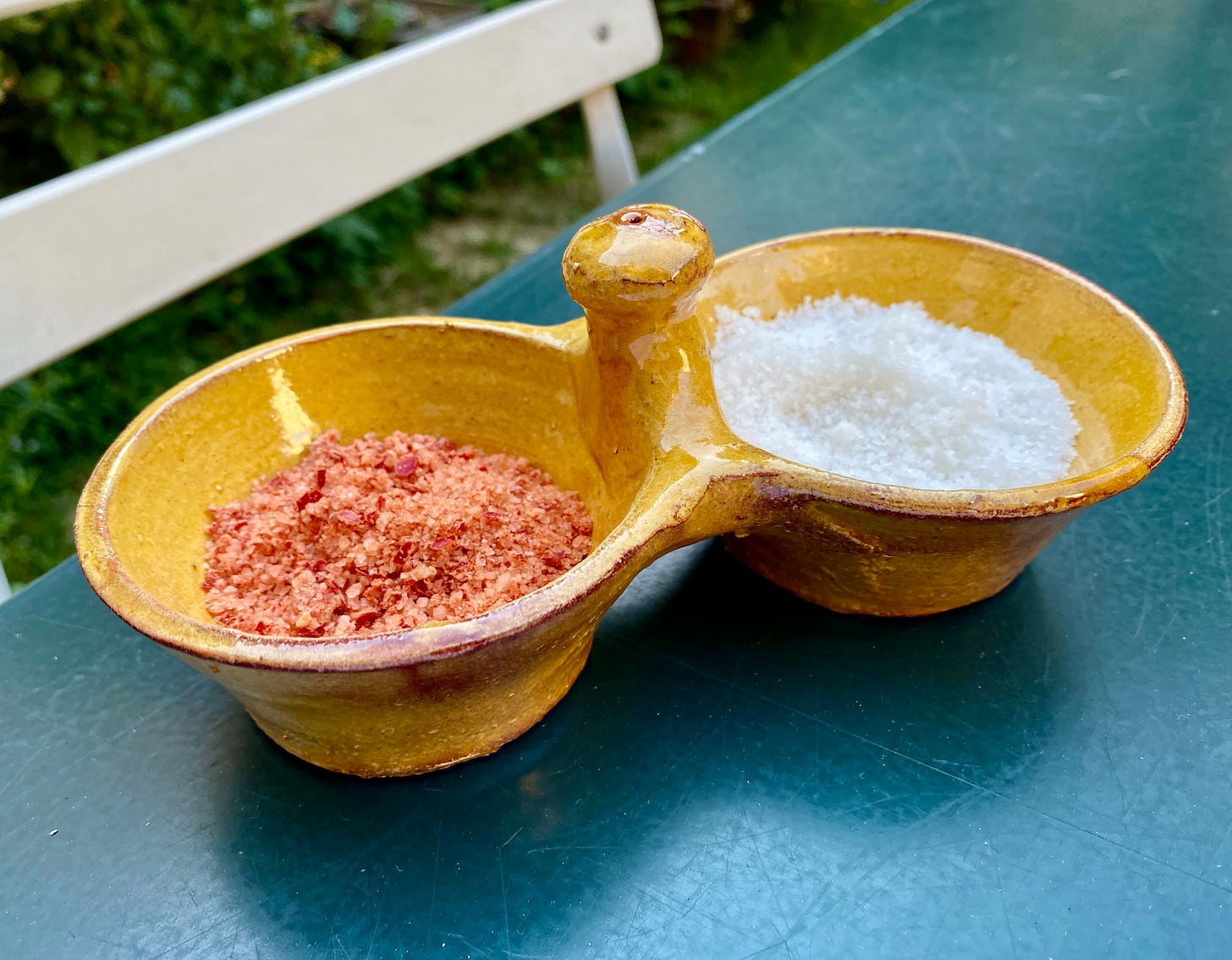



I really look forward to your posts! Thank you for distracting me from the doom and gloom of the newsfeeds!
Ha! I'll see your "change of address" at the bank and raise you my "change of address" driver's license. I moved to British Columbia (BC) from Alberta in March 2020, (yes, the beginning of COVID) and as a new resident, I needed a new drivers licence. The BC services website instructed me to bring a document showing proof of name change if your present driver's license or passport name is different from your birth surname. No problem. I brought my "marriage contract" from Quebec, where I got married, and where I "changed my name", which indicated the same sur name as my birth certificate, also from Quebec, which I also brought.
After making an appointment (COVID requirement) I was told that BC does not recognize Quebec marriage "contracts" (Napoleonic code) or birth certificates issued prior to 1992. I was born in 1947. Bring us a "marriage certificate" and an updated birth certificate. I tried to explain to the agent that I was moving from Alberta, a province right next door, not Uzbekistan. The response....."next"!
I wrote to Quebec requesting a marriage certificate, only to be told weeks later that the department was malade with COVID! Fast forward....the marriage certificate arrives but is stamped in large red letters "divorced". When I brought my two newly acquired required documents back to BC services (I had found among my papers a birth certificate dated 2004) I was told that I now needed to present a copy of my divorce certificate.
By now I was what you would call a "difficult" customer. But, having no choice, I begged a lawyer friend to expedite providing me with a copy of my divorce certificate. For some reason I'd lost it! Maybe it was an unconscious way of forgetting, who knows!
Documents in hand, again, I make another appointment. I have my: 2004 issued birth certificate, a marriage certificate, and my proof of failure, the divorce certificate. And, because I no longer trusted the system I brought along my "certificate of the sacrament of marriage". Quebec is French and most French, then, were Catholic , as was I. It couldn't hurt.
And voila! It worked. But, the agent told me that if I had brought the certificate of the sacrament of marriage in the first place (even though that wasn't on the accepted document list) she would have accepted it as valid proof of name change!
Welcome to BC.